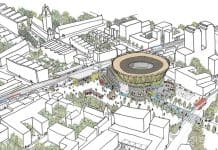UK lockdown made clear the importance of shelter for all, with government and local authorities mounting a significant effort to help almost 15,000 vulnerable people off the streets and into temporary accommodation. Richard Hyams, founder and director of astudio, explores the benefits of modular construction in a post-pandemic world
Whilst the additional £85m now pledged by ministers to continue this programme is welcome if we are to truly address homelessness in the UK – as well as support sustainability, building site safety and jobs – then we must turn to new solutions in design and construction.
Pace is paramount
The reality is that local authorities – many of whom are under enormous financial pressures – continued to miss their housebuilding targets last year. It seems clear, therefore, that to meet the UK Government’s pledge of 300,000 new homes annually, as well as 180,000 new affordable homes over the next 8 years, alternative methods to deliver projects at pace need to be explored.
Speed in delivery is one area where modular construction can offer significant benefits. Homes are pre-designed and efficiently manufactured offsite, meaning modular is not subject to the supply chain vulnerabilities or uncoordinated trades that can hamper traditional building sites. Indeed, modular homes can be assembled in as little as three days by smaller teams who can be trained in a matter of months rather than years.
Through greater adoption of such modern methods of construction, developers across the public and private sectors really could deliver homes faster and in greater volume. To understand the context of the pressing need, it is worth remembering that there are an estimated 62,820 homeless families in the UK.
Driving sustainable practice
Modular construction is able to help the UK meet its 2050 net-zero carbon emission targets. Indeed, the built environment, including the construction sector, accounts for 39% of all global carbon emissions, so more sustainable building practices clearly have to be part of the response to climate change.
Manufactured in highly controlled factory environments, modular homes maximise efficiency and minimise material waste at the construction stage, while the installation and assembly process requires less vehicle traffic than traditional onsite methods. It has been proven that up to 67% less energy is required to construct a modular building in comparison to traditional methods.
Beyond improving the construction process, the lifetime environmental impacts of a building is also an important consideration. Once again, modular construction can offer benefits. Most modular buildings requiring less energy to run in compliance with the latest L2 Building regulations governing thermal efficiency, on average delivering a lifetime energy saving of 90% compared to traditional buildings.
Moreover, not only can modular homes prove more cost-effective for residents due to their greater energy efficiency, but the reduced energy footprint of modular construction has potential to reduce costs for developers – in turn supporting more affordable housing to be built.
Jobs and safety first
Far from replacing traditional construction jobs, modular methods can help the construction industry get back to work. Indeed, there’s never been a greater need to get building again – not only to meet the homelessness crisis, but to make up for the huge drop in construction site productivity.
As the construction sector downed tools during lockdown, then grappled with the implications of social distancing to manage the safety of workers in an uncertain time, the IHS Market/Cips Construction Purchasing Managers Index fell to its lowest ever level since data was first collected in 1997. Moreover, estimates from the Construction Products Association have suggested that construction site productivity fell by 30%-40% during lockdown.
But with Office of National Statistics (ONS) figures now suggesting that output is slowly recovering, there is a clear need to adopt methods that can prioritise worker safety and wellbeing – especially if we are to minimise the chances of a second wave of Covid-19.
Again, this is where modular can play a role. Unlike conventional building methods, the highly controlled factory environment of modular construction allows social distancing to be safely and effectively managed, meaning that strong productivity levels can be maintained even if new Covid-19 health and safety measures remain in place in the long term.
Furthermore, by needing fewer team members on a building site, risks of infection spreading are vastly reduced by modular construction.
A watershed moment for change
Currently, the UK faces a gap between housing demand and supply estimated to be as high as 1 million homes. A figure that reflects the number of households on social housing waiting lists and, incredibly, 120,000 children alone currently housed in temporary accommodation.
Modular construction can help to deliver needed, high quality housing stock more sustainably, more affordably and at pace. astudio’s volumetric modular housing project at Desborough Road, a development of 58 units to provide shelter for rough sleepers for Wycombe District Council is testament to these benefits.
Just as the Government’s emergency housing of 15,000 former rough sleepers shows what can be done when pressed, the wider policy response to COVID-19 presents a once in a generation opportunity to solve homelessness.
I am convinced that modular is a part of that solution.
Richard Hyams
Founder and director














